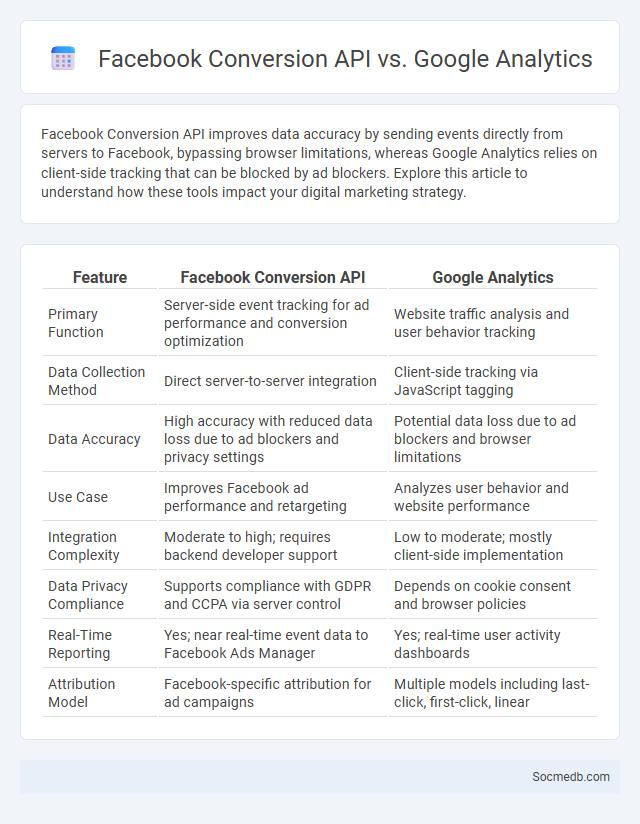
Photo illustration: Facebook Conversion API vs Google Analytics
Facebook Conversion API improves data accuracy by sending events directly from servers to Facebook, bypassing browser limitations, whereas Google Analytics relies on client-side tracking that can be blocked by ad blockers. Explore this article to understand how these tools impact your digital marketing strategy.
Table of Comparison
| Feature | Facebook Conversion API | Google Analytics |
|---|---|---|
| Primary Function | Server-side event tracking for ad performance and conversion optimization | Website traffic analysis and user behavior tracking |
| Data Collection Method | Direct server-to-server integration | Client-side tracking via JavaScript tagging |
| Data Accuracy | High accuracy with reduced data loss due to ad blockers and privacy settings | Potential data loss due to ad blockers and browser limitations |
| Use Case | Improves Facebook ad performance and retargeting | Analyzes user behavior and website performance |
| Integration Complexity | Moderate to high; requires backend developer support | Low to moderate; mostly client-side implementation |
| Data Privacy Compliance | Supports compliance with GDPR and CCPA via server control | Depends on cookie consent and browser policies |
| Real-Time Reporting | Yes; near real-time event data to Facebook Ads Manager | Yes; real-time user activity dashboards |
| Attribution Model | Facebook-specific attribution for ad campaigns | Multiple models including last-click, first-click, linear |
Introduction to Conversion Tracking Tools
Conversion tracking tools enable businesses to measure the effectiveness of social media campaigns by monitoring user actions such as clicks, sign-ups, and purchases. Platforms like Facebook Pixel, Google Analytics, and LinkedIn Insight Tag provide detailed insights into audience behavior and ROI. Harnessing these tools allows marketers to optimize ad spend, improve targeting, and increase conversion rates on social media channels.
What is Facebook Conversion API?
Facebook Conversion API is a powerful tool that enables direct data sharing between an advertiser's server and Facebook, bypassing browser limitations and improving event tracking accuracy. This server-to-server integration enhances data reliability for better ad performance measurement, audience targeting, and optimization. By capturing valuable conversion data, advertisers can optimize campaigns and maximize the return on ad spend.
Overview of Google Analytics Conversion Tracking
Google Analytics Conversion Tracking measures user actions such as purchases, sign-ups, or downloads to evaluate social media campaign performance. It uses tracking codes and event goals to attribute conversions from platforms like Facebook, Instagram, and Twitter accurately. Analyzing this data helps marketers optimize social media strategies for higher ROI and better audience engagement.
Understanding Conversion in Digital Marketing
Understanding conversion in digital marketing centers on transforming social media engagement into measurable actions, such as purchases, sign-ups, or inquiries. Your ability to analyze conversion rates from platforms like Facebook, Instagram, or LinkedIn helps optimize campaigns for better ROI. Effective tracking tools and audience segmentation are essential to identify which social media strategies drive meaningful user behavior and business growth.
Key Features Comparison
Social media platforms differ significantly in their core features, with Facebook emphasizing extensive networking capabilities and community group functionalities, while Instagram prioritizes visual content sharing through photos and short videos. Twitter is renowned for real-time news updates and concise messaging with a 280-character limit, facilitating quick information dissemination and trending topic engagement. LinkedIn specializes in professional networking, offering tools for job searching, industry news, and skill endorsements, making it ideal for career development and B2B interactions.
Data Privacy and User Consent
Social media platforms collect vast amounts of personal data, making data privacy a critical concern for users worldwide. Your consent should be explicitly obtained before any personal information is shared or processed, ensuring transparency and control over your digital footprint. Enhanced privacy settings and robust encryption methods are essential to protect your data from unauthorized access and misuse.
Implementation and Integration
Implementing social media strategies requires a comprehensive plan that integrates content creation, audience engagement, and performance analytics across platforms like Facebook, Instagram, and LinkedIn. Your business can leverage APIs and automation tools to streamline posting schedules and monitor real-time user interactions, ensuring consistent brand messaging. Seamless integration with CRM systems enhances customer insights, allowing for personalized marketing campaigns that drive higher conversion rates.
Accuracy and Data Attribution
Social media platforms rely heavily on accurate data attribution to maintain the integrity and trustworthiness of shared content. Your ability to verify sources and ensure precise attribution reduces the spread of misinformation and enhances the credibility of online interactions. Implementing stringent verification methods supports a transparent digital environment where information accuracy is prioritized.
Use Cases and Best Practices
Social media platforms facilitate diverse use cases including brand awareness, customer engagement, and targeted advertising, driving measurable business growth. Best practices involve consistent content scheduling, leveraging data analytics for audience insights, and fostering authentic interactions to build community trust. Employing platform-specific features like Instagram Stories, LinkedIn articles, or Twitter threads enhances reach and engagement effectiveness.
Choosing the Right Tool for Your Business
Selecting the right social media platform is crucial for maximizing your business reach and engagement. Consider factors such as your target audience demographics, industry trends, and content style to determine whether platforms like Instagram, LinkedIn, or Twitter align best with your marketing goals. Tailoring your strategy to the specific strengths of each tool ensures efficient resource allocation and enhanced brand visibility.
 socmedb.com
socmedb.com